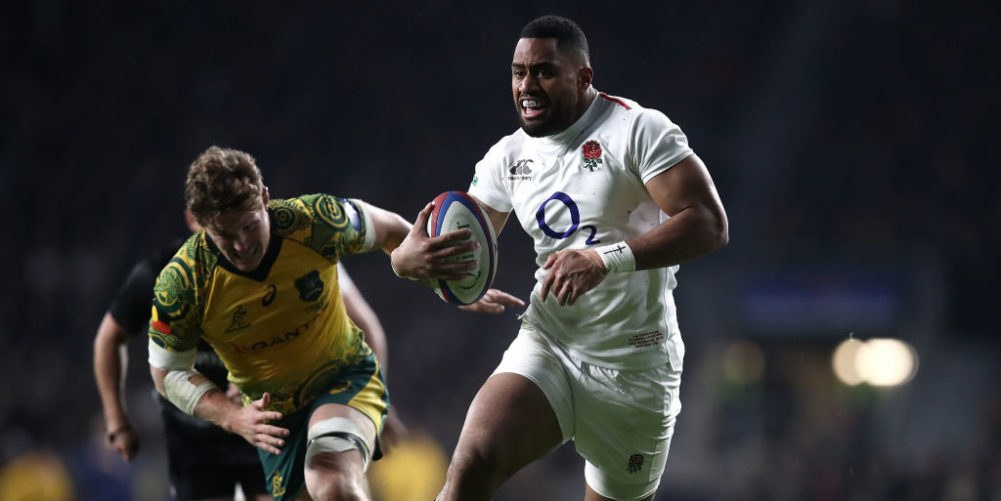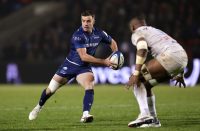JOE Cokanasiga could be the next big thing in English rugby – as big as Jonny Wilkinson and Martin Johnson, or in today’s terms Owen Farrell or Maro Itoje. He has that ability to make an impact every time he catches the ball.
Cokanasiga has the whole rugby world in front of him, and it is about how well he deals with the mental demands of becoming a star in rugby union that will dictate whether he makes the most of the opportunity.
With his second touch on his debut against Japan he took a pass from Elliot Daly and set off down the left wing before linking with Jamie George, who then sent Danny Care in for the first try. A new player coming in with Cokanasiga’s heft could easily have gone for glory and tried to score himself, but he chose the right option with a simple pass to somebody in a better position.
For his own try later on he got himself in support in the right position, and had the power and pace to ride the tackle and get over the line.
Moving on, in the game against Australia, there are very few wings – let alone one just starting out – who would have scored the try Cokanasiga did. Dane Haylett-Petty nearly knocked himself out trying to tackle him, before the big Bath wing took off between Sefa Naivalu and Michael Hooper to score.
Cokanasiga makes ground pretty much every time he gets the ball, but there are always lessons to be learned in this game, and he learned an important one when he was nailed and dumped backwards when he was given a hospital pass with three Wallaby tacklers lined-up opposite him.
When it comes to tackling very few wings have a massive reputation for their defence. This is because, like the No.9 in football, wings in Rugby Union are the finishers.
The balance between what a player can do in attack, and how costly they can be in defence is a factor that all coaches have to contend with.
For instance, Billy Vunipola is renowned for big carries much more than the big hits made by players like Sam Underhill and Courtney Lawes. A No.8 like Billy has to work hard to make sure that his defensive game is not left behind by his attacking strength.
With Cokanasiga it is harder because defensively he is in a more exposed position than a No.8. The further out you are on the flanks the more difficult it is to know when to stay out and when to come in. Let’s not forget that Joe is very much a rookie, and he will rely on his coaches and the outside-centres he plays with to fast-track his reading of the game.
In the 44th minute of the match against Japan he timed a tackle to perfection when he came in to nail one of the Japanese replacements. However, in the first half when he came in to tackle his opposite winger, Akihito Yamada, he did not wipe him out – and it allowed him to make the offload that Japan captain Michael Leitch scored from.
So, even though he bumped off Haylett-Petty successfully, Cokanasiga learned that he has to make his tackles count enough to either stop the off-load, or to slow it down. He was not alone because three other England defenders failed to stop the Japan captain.
In the 37th minute Joe also missed another tackle down the left flank that led to Leitch running on and Japan nearly scored again in the first-half. The lesson there was that he has to get his technique and position right if he is going to succeed in sacking the player running at him.
When the attack comes his way it is all about being able to anticipate where the ball will come, and how, so that he is in a position to cover it. The main challenge for any big winger in defence is to turn and recover when kicks are put in behind you – and because on the whole they do not turn quickly that is why anticipation is so important.
Against Australia he also did what Dick Best used to call a “Carruthers” – a less than robust challenge – where he allowed himself to be tackled into touch instead of angling in-field earlier.
These are all constructive criticisms based on detail because Cokanasiga’s overall performance was one of huge promise. England greats like Wilkinson and Johnson were able to slot into international rugby instantly because they were already very accomplished, and with the right mental application Cokanasiga could be that good too.

It might not all be plain sailing because when you are a big man who is that quick there are a lot of stresses on joints, future injuries may be a factor but let’s hope not. It was interesting seeing him opposite Israel Folau, who is slightly taller but has a highly fluid running action.
Folau is very well-balanced and it allows him to make easy changes of direction, whereas Cokanasiga appears to be more about raw power. He also has incredible dexterity and agility, which he showed earlier this season with the try he scored for Bath against Harlequins. So far, we’ve seen only glimpses of his potential.
The way he took the high ball and burst downfield to the Australian line was one of those glimpses – even though he failed to see that he had Henry Slade free outside him. However, the way he caught a high ball and then left Wallaby defenders standing means that you kick to him at your peril.
Folau was the master of scoring from the kick-pass when he was in Aussie Rugby League. If I’m a winger of Cokanasiga’s size it is a skill that I would want in my locker – and if he acquires it he will be almost impossible to defend against.
I’m so impressed by what we’ve seen of Joe this autumn. He carried nine times against Japan and seven against Australia, and you want him with the ball in his hands because most times he will do damage.
Cokanasiga can have the effect he had on Haylett-Petty against anyone who doesn’t get their technique right when they attempt to tackle him, and if he adds handling and offloads to his dexterity then his threat will be about more than power. He has balance and agility, and is a bit like a cross between George North, who is a piston-power runner, and a flowing runner like Folau – with North’s power and Folau’s dexterity.
Australia are usually tactical and strategic, and I thought they would try to isolate Cokanasiga, and then expose him. In the 2015 World Cup the Wallabies pulled the English defence where they wanted them, and I feared that they would have done enough homework on the rookie to try and put him in no-man’s land.
It didn’t happen because England didn’t allow Australia to get going, and I’m so pleased because it gives Joe enough time to work on his defence before the Six Nations.
The dynamic in the English team with Cokanasiga, Manu Tuilagi and Ben Te’o is different. It gives England a power and physicality in the backline that they have not had since Will Greenwood, Mike Tindall and Ben Cohen helped them win the 2003 World Cup.
Cokanasiga has his work-ons in terms of improving his defence, and his kick-pass receiving in attack, but overall he has to be a coach’s dream. He has all the attributes, and it is up to the coaches he works with to develop them to the full so that he becomes one of the greats.
Cokanasiga can create havoc. You know he’s coming, but you’ve still got to stop him – and if there are two defenders and the England winger is five yards from the try line then all you can do is wish them luck. Because they are going to need it.
JEREMY GUSCOTT























